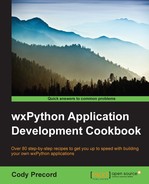Book Description
Over 80 step-by-step recipes to get you up to speed with building your own wxPython applications
About This Book
- This book empowers you to create rich cross-platform graphical user interfaces using Python
- It helps you develop applications that can be deployed on Windows, OSX, and Linux
- The recipes in the book involve real-world applications, giving you a first-hand experience of the practical scenarios
Who This Book Is For
For those who are familiar with programming in Python and want to start building applications with graphical user interfaces, this book will get you up and running quickly. A basic understanding of the Python programming language and object-oriented concepts are all that is needed.
What You Will Learn
- Create full featured user interfaces
- Design and develop custom controls
- Deploy and distribute wxPython applications to Windows, Macintosh OS X, Linux, and other UNIX-like environments
- Handle and respond to application events
- Manage and display data using grids
- Interact with web services from your GUI
- Use Paint events to draw custom displays
- Support the display of user interfaces in multiple languages
In Detail
wxPython is a GUI toolkit for the Python programming language built on top of the cross-platform wxWidgets GUI libraries. wxPython provides a powerful set of tools that allow you to quickly and efficiently building applications that can run on a variety of different platforms. Since wxWidgets provides a wrapper around each platform’s native GUI toolkit, the applications built with wxPython will have a native look and feel wherever they are deployed.
This book will provide you with the skills to build highly functional and native looking user interfaces for Python applications on multiple operating system environments. By working through the recipes, you will gain insights into and exposure to creating applications using wxPython. With a wide range of topics covered in the book, there are recipes to get the most basic of beginners started in GUI programming as well as tips to help experienced users get more out of their applications. The recipes will take you from the most basic application constructs all the way through to the deployment of complete applications.
Style and approach
This book is a collection of step-by-step recipes that introduce the various components and concepts of wxPython in a conversational and easy-to-follow way. Each recipe contains coded examples along with detailed explanations about the key points of each topic. Each topic is designed to introduce and show you how to use a single feature from the wxPython library.
Downloading the example code for this book. You can download the example code files for all Packt books you have purchased from your account at http://www.PacktPub.com. If you purchased this book elsewhere, you can visit http://www.PacktPub.com/support and register to have the code file.
Table of Contents
- wxPython Application Development Cookbook
- Table of Contents
- wxPython Application Development Cookbook
- Credits
- About the Author
- About the Reviewers
- www.PacktPub.com
- Preface
- 1. wxPython Starting Points
- 2. Common User Controls
- 3. UI Layout and Organization
- Introduction
- Laying out controls with Sizers
- Controlling layout behavior
- Grouping controls with a StaticBox control
- Creating an automatic wrapping layout
- Using the standard dialog button sizer
- Simplifying the panel layout
- Making dialog layout easy
- Building XML resource-based layouts
- Extending XRC for custom controls
- Advancing your UI with AuiManager
- 4. Containers and Advanced Controls
- Introduction
- Adding tabs with the Notebook control
- Enhancing ComboBox with bitmaps
- Configuring properties
- Taking control with FlatNotebook
- Styling text in StyledTextCtrl
- Annotating StyledTextCtrl
- Displaying hierarchical data with TreeCtrl
- Building a system tray application
- Surfing the Web in your app
- 5. Data Displays and Grids
- 6. Ways to Notify and Alert
- 7. Requesting and Retrieving Information
- 8. User Interface Primitives
- 9. Creating and Customizing Components
- 10. Getting Your Application Ready for Release
- Index
